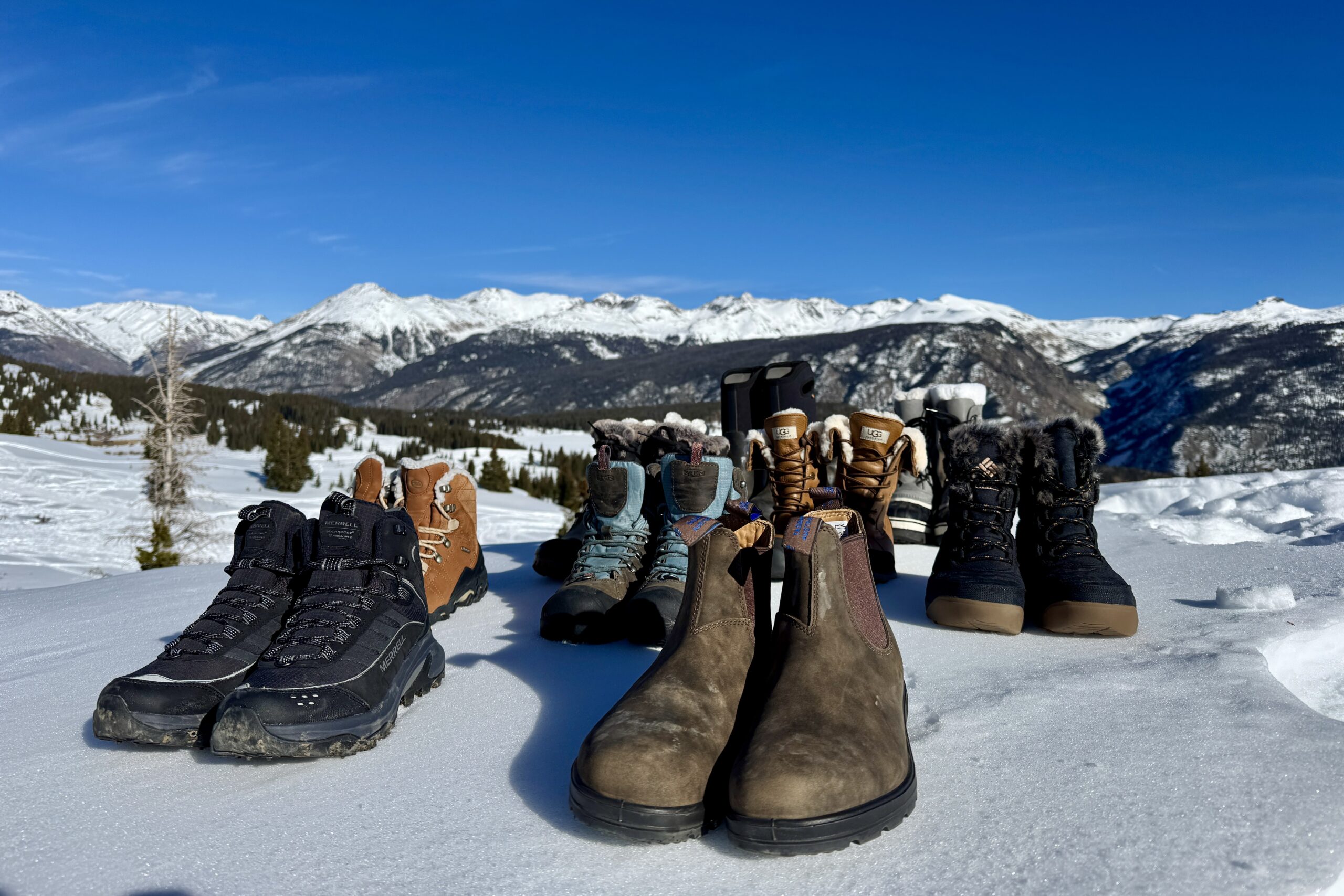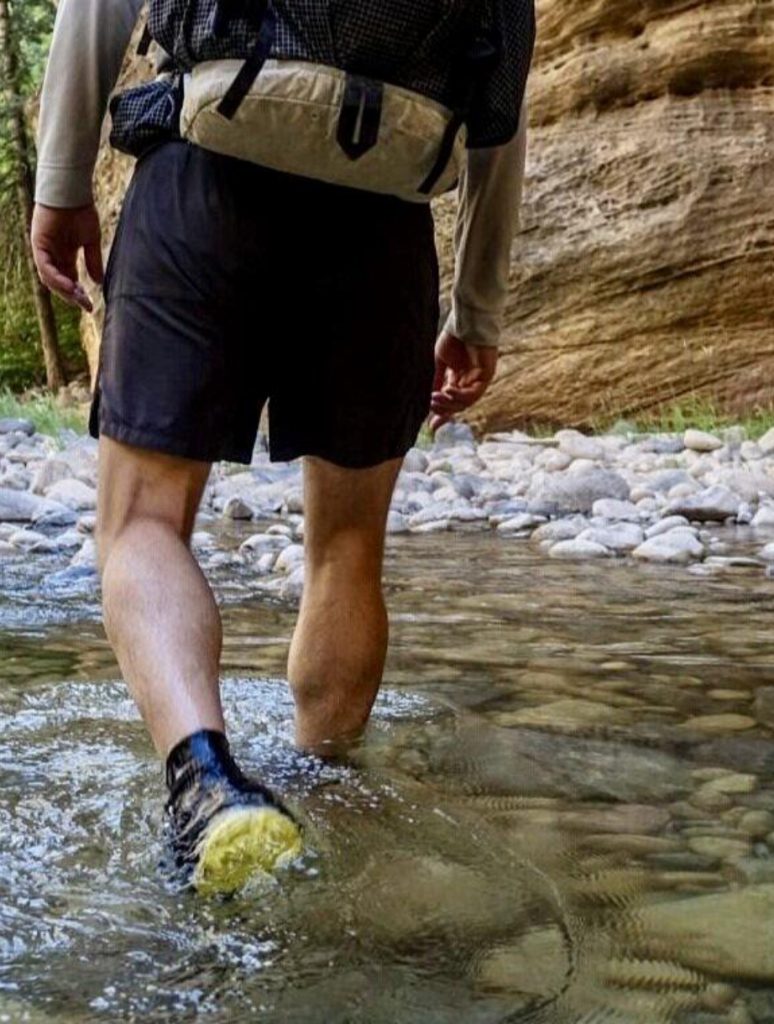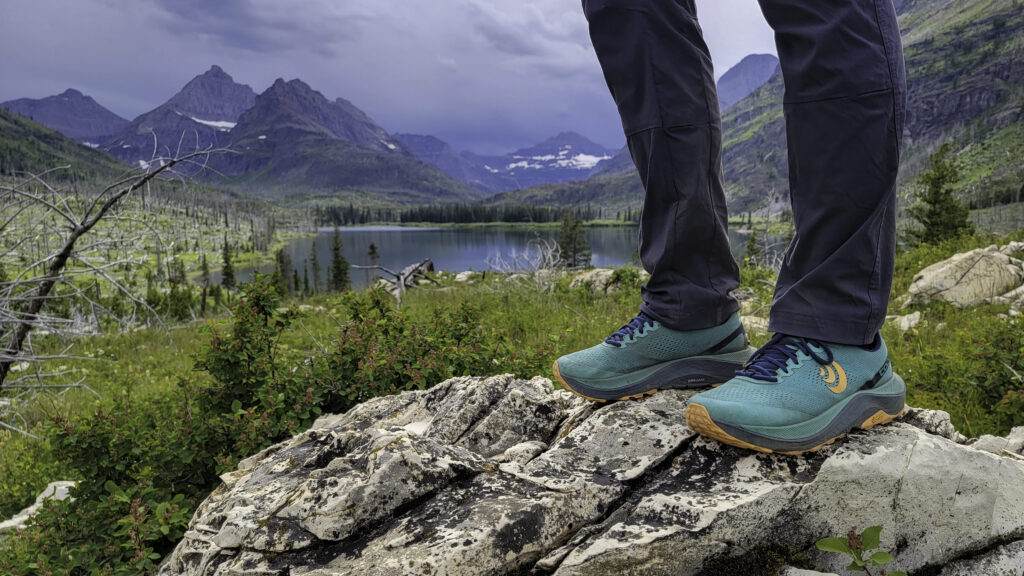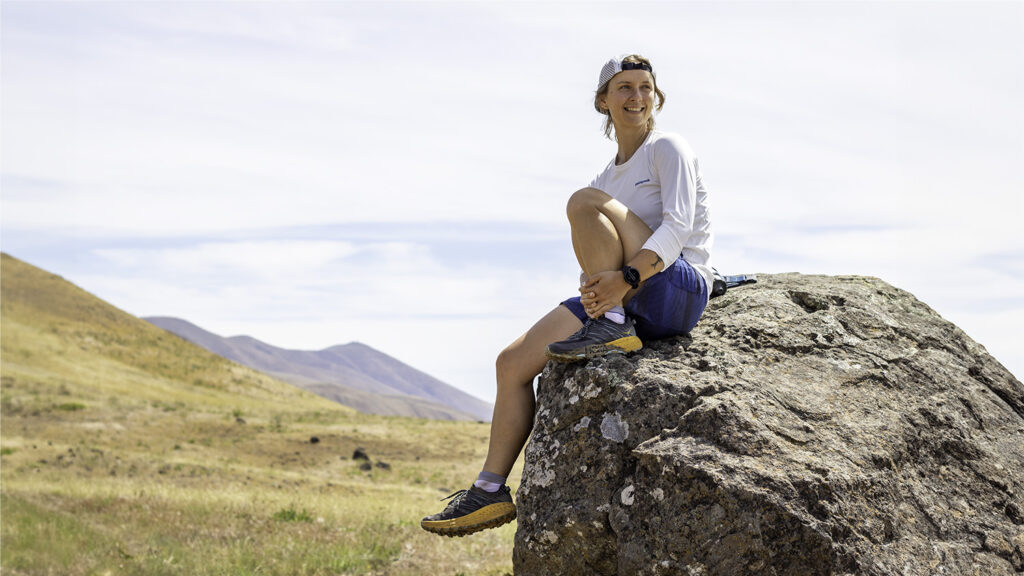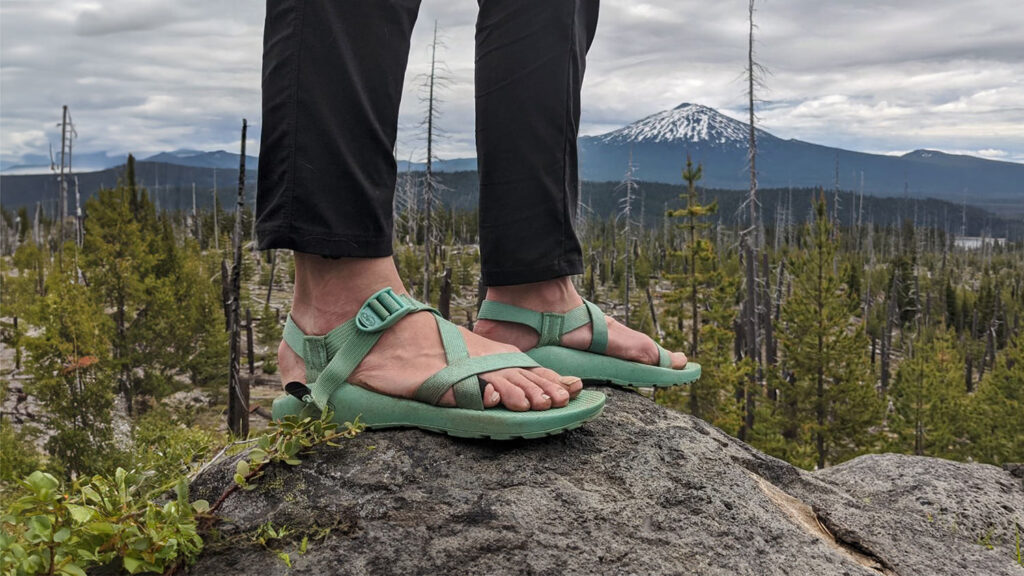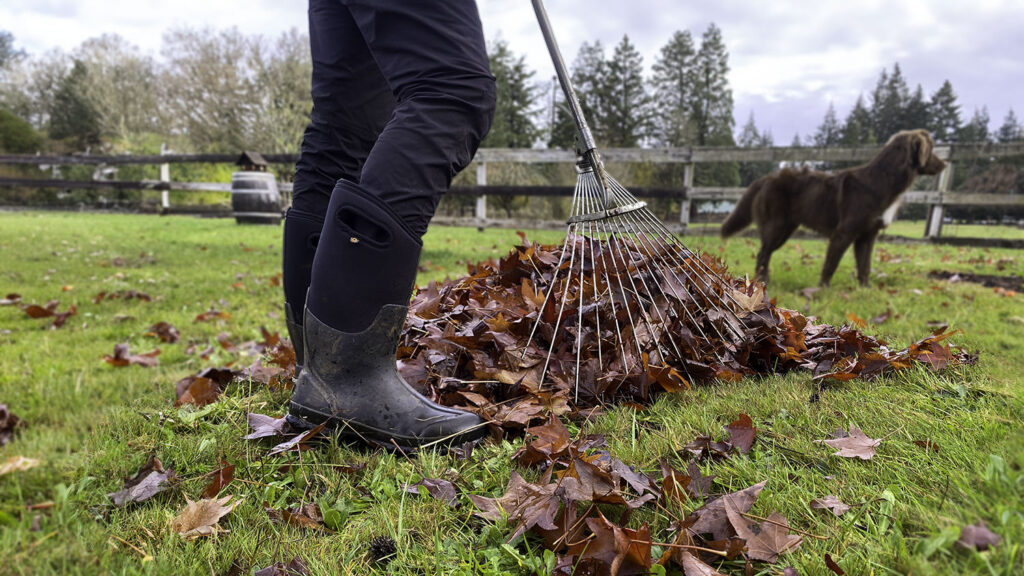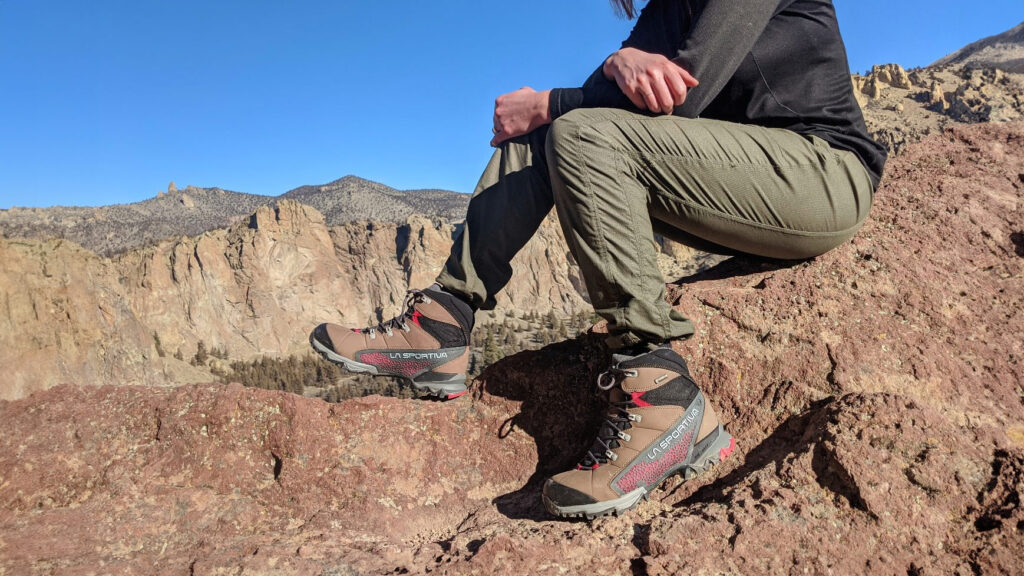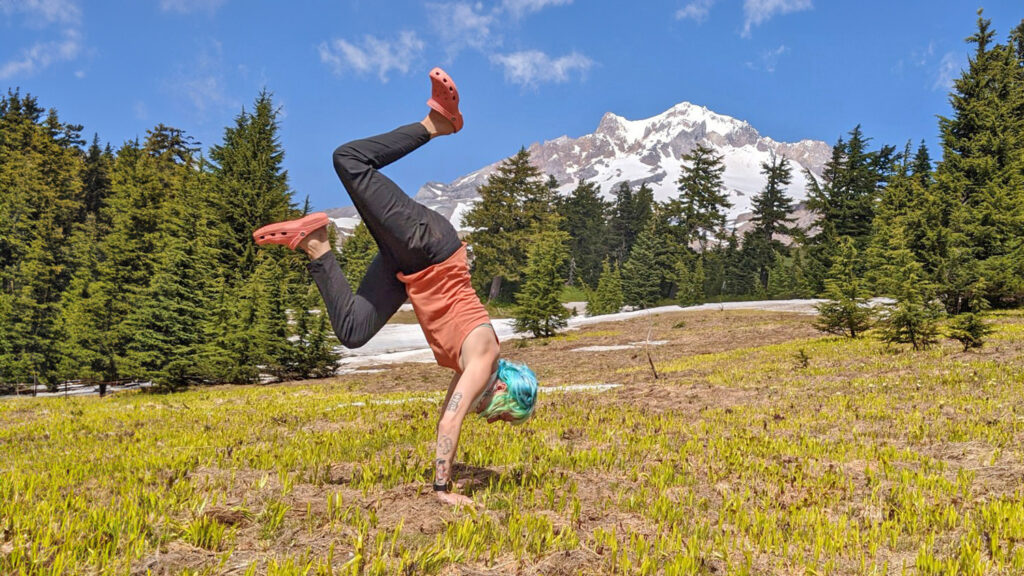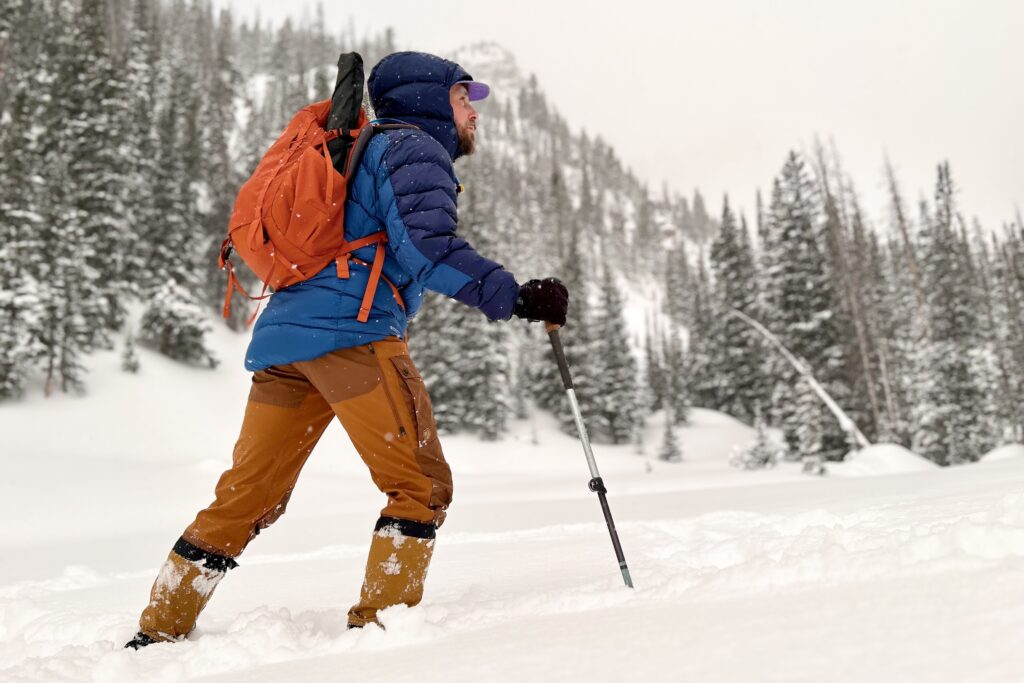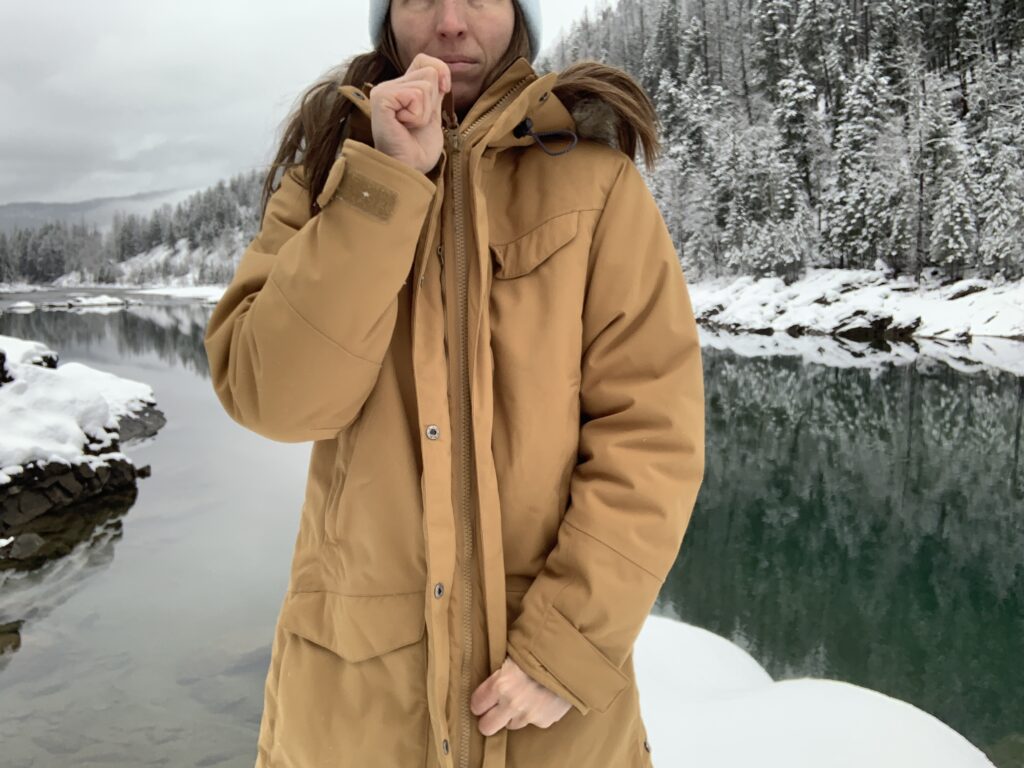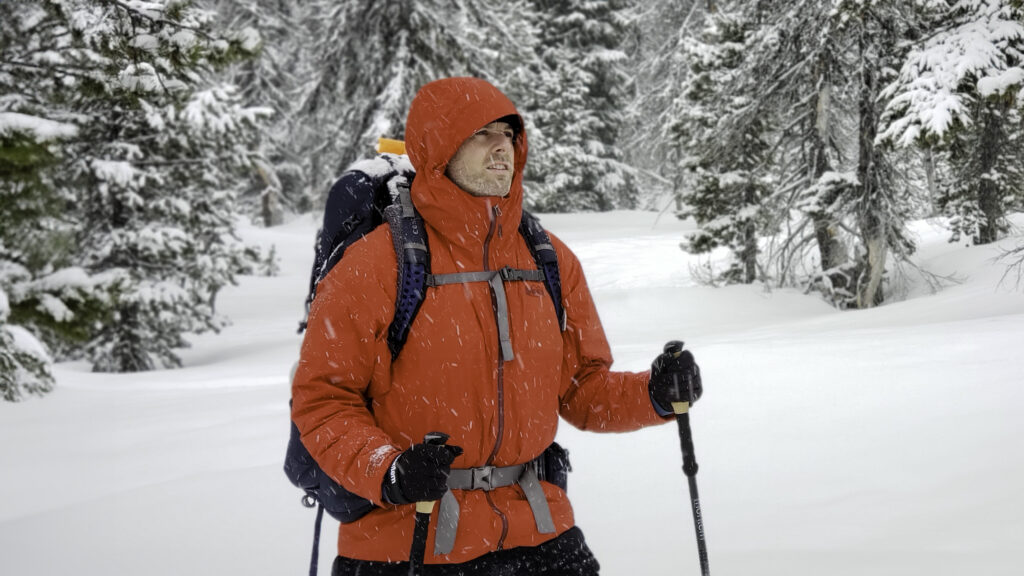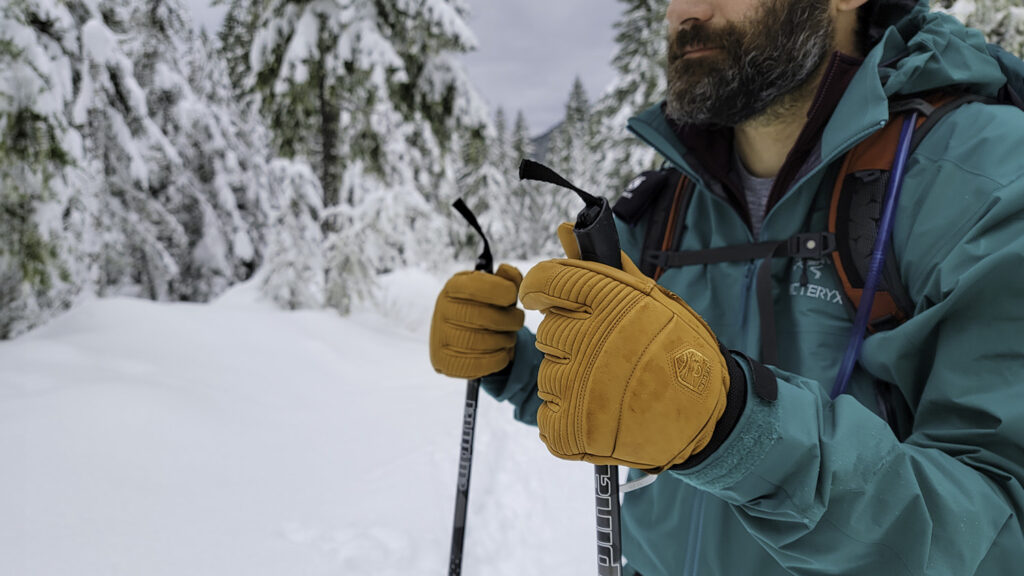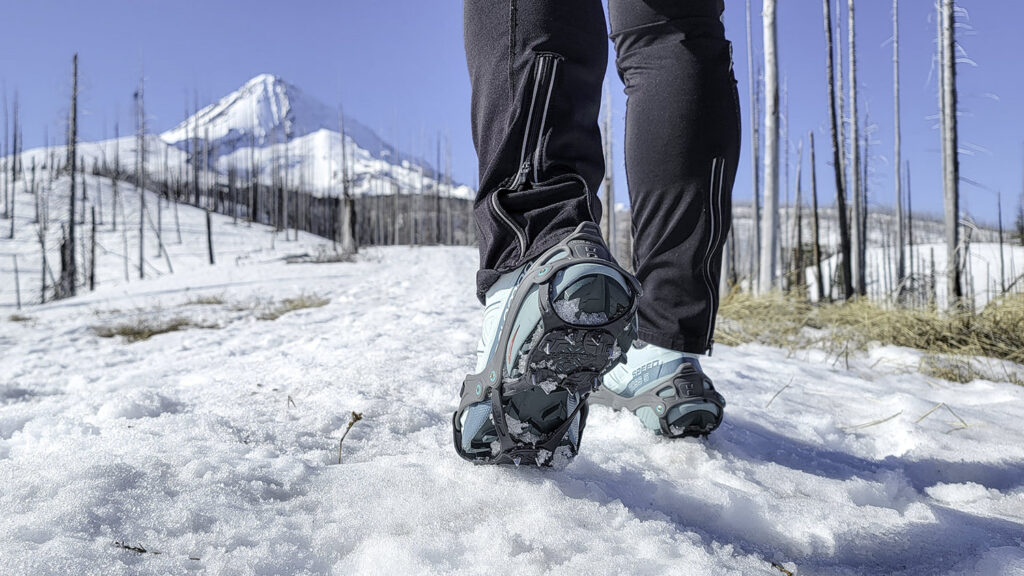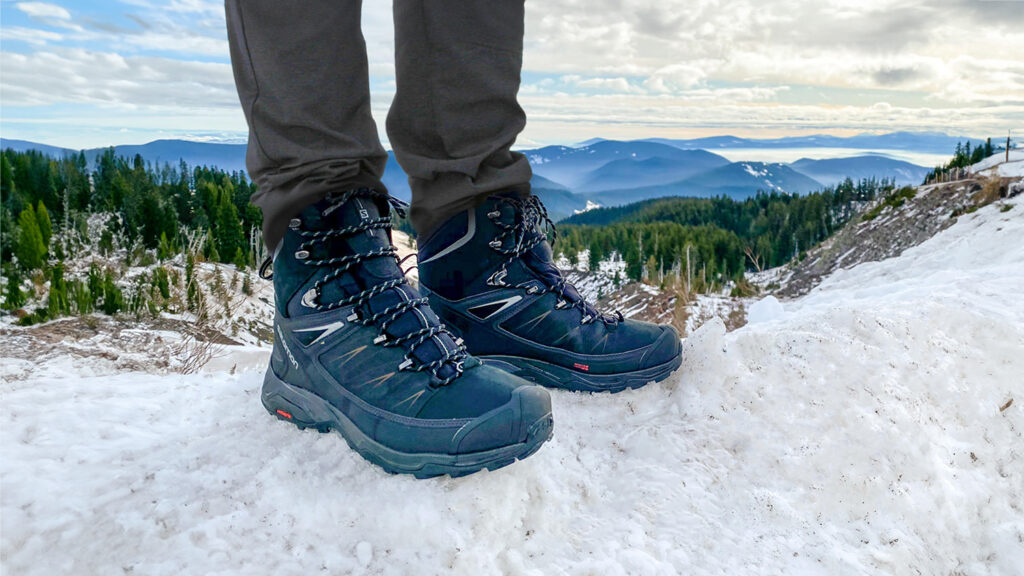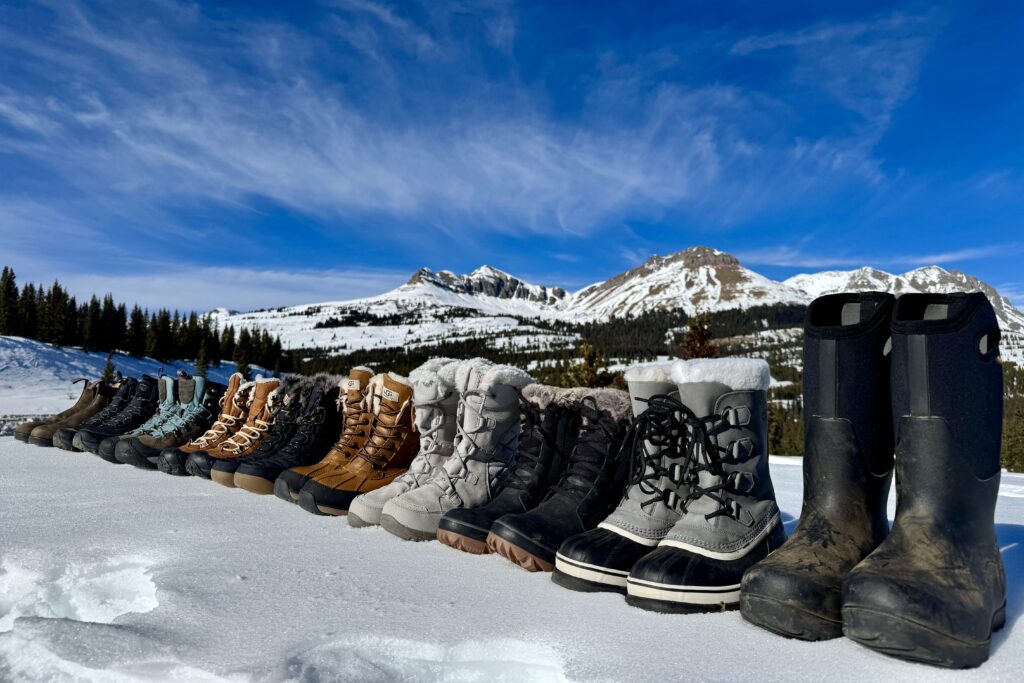
Rain, snow, and mud don’t have to dampen your day outdoors. There are many boots designed to keep your feet dry, no matter where you go or what you do. We tested winter boots for weight, water resistance, warmth, comfort, and traction to identify the 10 best models. These boots were worn anywhere and everywhere including to work, the ski hill, and winter hikes. Using a lifetime of experience living and playing in snowy environments like Alaska, we were able to rank the boots and provide insight to help you choose the best boot for your adventure.
And for more info, check out some of our other most popular gear guides:
Quick Picks for Women’s Winter Boots
Check out this quick list of our favorites, or continue scrolling to see our full list of the best winter boots with in-depth reviews.
Best Winter Hiking Boots Overall: Oboz Bridger 7” Insulated ($210)
Most Versatile Boot: UGG Adirondack III ($250)
Best Boot for Casual Use: Blundstone Thermal Women’s Chelsea ($230)
Most Comfortable Winter Boot: Columbia Minx Shorty IV ($110)
Best Slip on Boot: Bogs Arcata Snow Boot ($160)
Best Waterproof Boot: Bogs Neo Classic Tall ($140)
Best Lightweight Hiking Boot: Merrell Thermo Chill Mid ($130)
Best Hiking Boot for Comfort: Keen Revel IV Polar ($190)
Best Boot for Snow: Sorel Caribou ($200)
Most Affordable Boot: Columbia Ice Maiden II ($100)
What’s new
We brought in some new winter boots and took the best into the field. After rigorously reviewing their performance capabilities, we’ve made some updates to our list:
- After more rigorous testing, the Oboz Bridger 7” Insulated moved into first place thanks to its well-rounded design.
- We brought in the UGG Adirondack III boots and found that its versatility makes them an excellent choice.
- The new version of the Columbia Minx Shorty boots came out and continued to perform well, earning a top spot.
Women’s Winter Boots Overall Testing Scores
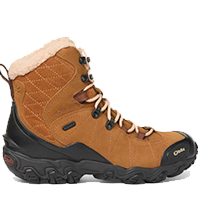
Oboz Bridger 7” Insulated
Best Winter Hiking Boots Overall
CleverHiker Rating: 4.6/5.0
Price: $210
Weight: 2 lb. 9 oz.
Temperature Rating: Not rated
Insulation: 200 g Synthetic fibers
Also Available In: 9″
Sizing: True to size
Pros
- Highly resistant to water
- Warm
- Synthetic wool lining is cozy
- Good traction
- Stylish for a hiking boot
- Gaiter attachment loops
Cons
- Expensive
- Needs a gaiter in deep snow
Our top-ranked boot, the Oboz Bridger 7”, performs well across the board, from water resistance and warmth to comfort and traction. We were particularly impressed by how resistant these boots are to moisture. Even after two hours submerged in several inches of water, they remained completely dry inside.
Furthermore, these boots didn’t get nearly as cold as the others we tested when left in a snowdrift. Although these boots are designed primarily for hiking, we wore them to the office several times. Each time we wore them, we received at least one compliment.
They are a bit on the pricey side, but they deliver such value that the cost is well justified. We recognize that these boots might not be suitable for every situation, but they are definitely a fantastic option to consider.
More: Women’s Oboz Bridger 7” Insulated Winter Boot Full Review
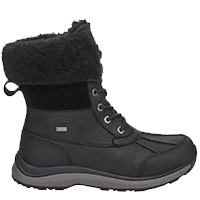
UGG Adirondack III
Most Versatile Boot
CleverHiker Rating: 4.6/5.0
Price: $250
Weight: 2 lb. 8.6 oz.
Temperature Rating: -25°F
Insulation: 200 g Upcycled Wool
Also Available In: Tall
Sizing: Runs small; we recommend choosing a half size larger
Pros
- Warm
- Waterproof
- Versatile
- Uppers can be rolled up or down
- Lightweight for a snow boot
Cons
- Expensive
Whether you’re going out for a nice dinner in winter, shoveling snow from the driveway, or hiking on a well-packed trail, the Adirondack boots are perfect for all occasions. This boot features several aspects that make it a rockstar in every way.
The most notable feature is the wool lining, which is visible when the uppers are rolled down. Unlike the linings in many other boots, this one extends all the way inside, making it incredibly warm. The leather exterior is also functional: these boots are incredibly waterproof. They remained bone dry when submerged in several inches of water for two hours during our side-by-side test.
While wearing these boots to work for nine hours, they felt relatively comfortable, partly due to their lighter weight compared to other snow boots. Finally, they offer a respectable amount of traction, meaning they are useful for hiking as well.
Overall, they may not be the best at any single activity, whether it’s casual use, winter boot performance, or hiking. However, they excel in all three areas, offering incredible value and making them well worth the price.
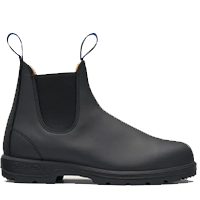
Blundstone Thermal Women’s Chelsea
Best Boot for Casual Use
CleverHiker Rating: 4.4/5.0
Price: $230
Weight: 1 lb. 13.8 oz.
Temperature Rating: Not rated
Insulation: Synthetic Fibers
Also Available In: Original, high topped boot, heeled
Sizing: Blundstones come in Australian sizing, make sure to look at the sizing chart before buying online
Pros
- Leather upper is highly water resistant
- Wool lined insole is warm
- Light weight design
- Casual aesthetic
Cons
- Expensive
- Low tops let in moisture
The Blundstone Thermal Women’s Chelsea boots are an excellent choice for casual winter footwear. These boots are designed more like shoes with a short upper and less aggressive tread, making them ideal for the office or running errands around town.
They perform better in snow and cold conditions compared to clogs, Vans, or other casual shoes. This is because they are made of leather with a wool-lined insert, which makes them highly resistant to moisture and warm to wear. Their shorter height also contributes to their lighter weight, making them easier to move in and more comfortable for extended periods. However, this also means they are not suitable for deep snow.
We frequently wore these boots in an office setting and found them comfortable even after nine hours on our feet, and they blended well with office attire. While these boots are somewhat pricey, considering they are made of quality leather and perform well, we believe the price is justified.
More: Women’s Blundstone Thermal Chelsea Winter Boot Full Review
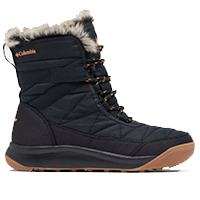
Columbia Minx Shorty IV
Most Comfortable Winter Boot
CleverHiker Rating: 4.3/5.0
Price: $110
Weight: 1 lb. 8 oz.
Temperature Rating: -25°F
Insulation: 200 g Synthetic Fibers
Also Available In: Regular & Mid
Sizing: True to sizing
Pros
- Affordable
- Comfortable
- Stylish
- Lots of sizing options
Cons
- Water resistant fabric is NOT waterproof
- Minimal insulation
One of our favorite shoes for outings, the Minx Shorty boasts many great features, including a minimalistic yet comfortable design. We often choose to wear these boots to work instead of others in our lineup. This is because they keep our feet from getting tired by the end of the day, are not too hot to wear indoors, are easy to move in, and pair well with various outfits.
From a performance perspective, these boots are certainly designed for winter, but they don’t perform well long-term in winter conditions. When we submerged them in several inches of water for the water resistance test, they lasted about 45 minutes before absorbing moisture. This means they are fine for walking through the occasional puddle, but probably won’t withstand a full day of rain. We also discovered that their insulation isn’t the best. This is beneficial if a significant amount of time spent in these boots will be indoors, but not ideal for sitting outside.
Given that the traction is adequate, these boots could potentially be used for shorter hikes on packed trails. However, they are best suited for casual use based on our experience. With a very affordable price tag, we highly recommend these boots as they offer great value.
More: Women’s Columbia Minx Shorty IV Winter Boot Full Review
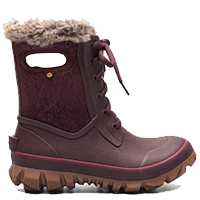
Bogs Arcata Snow Boot
Best Slip on Boot
CleverHiker Rating: 4.3/5.0
Price: $160
Weight: 3 lb. 1 oz.
Temperature Rating: -58°F
Insulation: 7 mm Neo-tech neoprene
Also Available In: Urban leather tall, urban leather mid, urban leather chelsea
Sizing: True to sizing
Pros
- Waterproof
- Easy to slip on
- Faux fur is cozy
- Beefy tread
Cons
- Mid-height can let deep snow in
- Heavy
We love using the Arcata boots for quick trips outside in the snow. These boots were our first choice for walking the dog in the middle of the night because they’re easy to slip on and keep your feet warm.
We found the faux fur lining, in particular, made them cozy and comfortable. The neoprene construction is another significant advantage: during both side-by-side testing and field use, these boots stayed bone dry when submerged in water. This was much appreciated when our vehicle was surrounded by puddles at the end of a long day of skiing.
These boots are a bit more fashionable than other rubber boots, but they do stand out compared to some of the other models we tried. We generally avoided wearing them to the office. They are also somewhat heavy and not as adjustable as other boots. However, we still genuinely enjoyed wearing them, and our testers found them to be quite comfortable. With an average price point, we would highly recommend them.
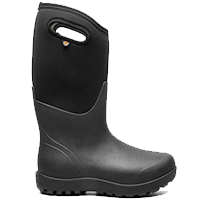
Bogs Neo Classic Tall
Best Waterproof Boot
CleverHiker Rating: 4.2/5.0
Price: $140
Weight: 3 lb. 6 oz.
Temperature Rating: -58°F
Insulation: 5 mm Neo-tech neoprene
Also Available In: Mid & Wide calf
Sizing: Runs large, we recommend sizing down half a size if you are unsure
Pros
- Durable
- Seamless neoprene lower is waterproof
- Tall height keeps out snow
- Moderate insulation is ideal for high output activities
Cons
- A bit heavy
- Not many adjustability features
Much loved by ranchers for their waterproof abilities and moderate insulation, the Neo Classic Tall boots serve as an excellent choice for outdoor work. These boots are our top pick for wet conditions because the seamless neoprene soles guarantee that water will not seep inside. The tall, fitted design of these boots also helps ensure that moisture is unlikely to enter from above.
While the tread and insulation did not perform the best during our side-by-side tests, our experience shows that they are satisfactory for outdoor work in harsh conditions. These boots are somewhat heavy, especially if not properly sized, which can result in some fatigue after a long day.
However, the advantages far outweigh any drawbacks with these boots, particularly in scenarios where durability is crucial. With a reasonable price point, these boots make a great choice for use in snowy conditions.
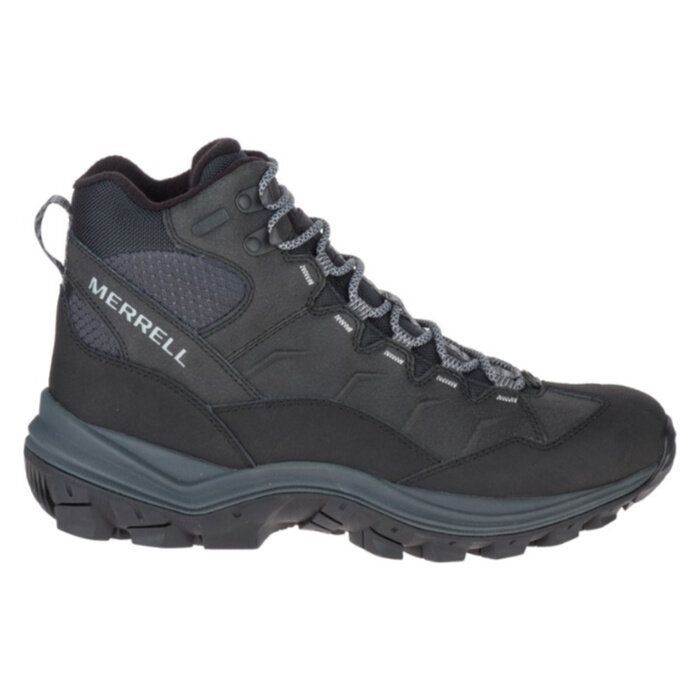
Merrell Thermo Chill Mid
Best Lightweight Hiking Boot
CleverHiker Rating: 4.2/5.0
Price: $130
Weight: 1 lb. 14 oz.
Temperature Rating: Not rated
Insulation: 200 g synthetic, micro-fleece lining
Also Available In: None Listed
Sizing: Fits a bit tight, we recommend sizing up half a size
Pros
- Very water resistant
- Gaiter attachment loop
- Reflective strips for nighttime visibility
- Grid fleece lining
- Lightweight
- Affordable
Cons
- Ankle design may not be comfortable for everyone
- Traction is a bit lacking for a winter boot
Those looking to purchase a year round hiking boot with stellar performance in wet conditions should consider the Merrell’s Thermo Chill Mid Boots. We were incredibly impressed with this boot’s ability to stay dry even when submerged in water for extended periods. Given how lightweight this boot is, it makes an excellent choice for long hikes when puddles or other moisture are likely. It even features a gaiter attachment loop to increase water resistance.
These boots provide average insulation, making them well-suited for walking all day rather than spending extended periods without movement. Because they are specifically designed for hiking, they can be less convenient to put on and take off and do not blend in well at the office or in more casual settings. Instead, they incorporate elements like reflective strips for visibility and metal shoelace eyelets for adjustability.
We did experience some discomfort from the shape of these boots rubbing our ankles, but this can vary from person to person depending on the size and shape of both the boots and the wearer’s feet. Overall, these are worth a try as they are affordable.
More: Women’s Merrell Thermo Chill Mid Winter Boot Full Review

Keen Revel IV Polar
Best Hiking Boot for Comfort
CleverHiker Rating: 4.1/5.0
Price: $190
Weight: 2 lb. 8.64 oz.
Temperature Rating: -25°F
Insulation: 200 g synthetic Fiber
Also Available In: High top
Sizing: True to sizing
Pros
- Grippy tread
- Gaiter attachment loop
- Metal shoelace eyelets for durability and adjustments
Cons
- Tongue lets water leak in
The Keen Revel IV Polar is the quintessential hiking boot in both looks and feel. We like to wear this boot for hiking because it is relatively comfortable and easy to walk in. The lighter weight of this model, coupled with the shape of the ankle supports, makes hiking and climbing effortless.From our experience, the tread is grippy and offers good traction when scrambling or navigating more challenging terrain.
These boots also include features specific to hiking, such as an attachment point for gaiters and multiple points for lace adjustments.
However, we advise hikers to be cautious when using these boots in wet conditions, as they are the least water-resistant of all the boots we tested. That said, for hard-packed and dry trails in the winter, these boots are an excellent choice!
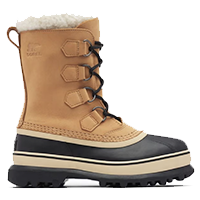
Sorel Caribou
Best Boot for Snow
CleverHiker Rating: 4.1/5.0
Price: $200
Weight: 3 lb. 6 oz.
Temperature Rating: -40°F
Insulation: 9 mm Recycled felt
Also Available In: Wool liner
Sizing: True to sizing
Pros
- Durable
- Waterproof
- Snow cuff to keep snow out of boot
- Removable felt inserts
Cons
- Expensive
- Heavy
For excellent performance in powder, the Sorel Caribou come through thanks to their excellent water resistance, moderate insulation, and decent tread. We have been using these boots for years and love them for big snow days.
They are easy to slip on, and the snow collar helps keep snow from getting inside the boots during powder days. If they get wet, the felt insert can be removed to speed up drying. One drawback of these boots is how heavy and clunky they can feel. This isn’t too noticeable for short-term use, but it can lead to foot fatigue after a long day. Proper sizing also greatly affects how easy these are to walk in.
Additionally, these boots are somewhat pricey. That said, we believe they are worth the investment as they offer exceptional durability.
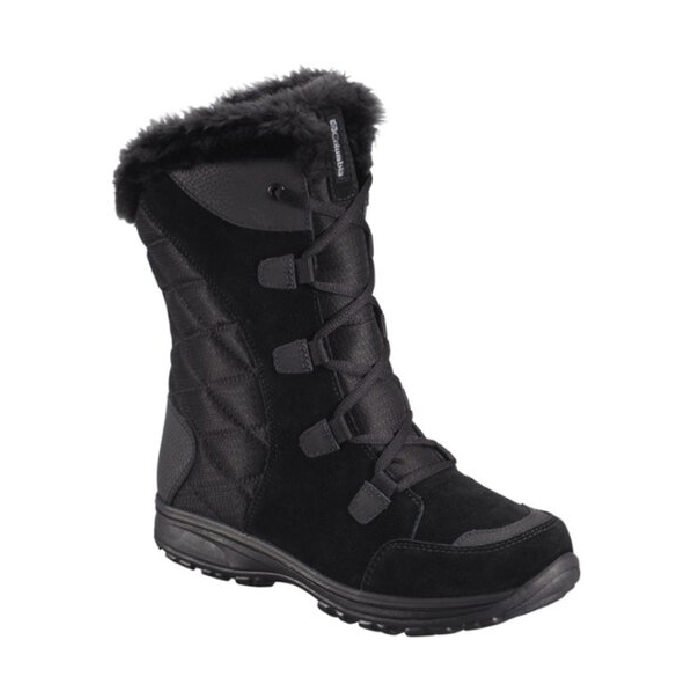
Columbia Ice Maiden II
Most Affordable Boot
CleverHiker Rating: 4.1/5.0
Price: $100
Temperature Rating: -25°F
Insulation: 200 g Synthetic fibers
Weight: 2 lb. 1.6 oz.
Also Available In: Slip-On, Shorty
Sizing: True to sizing
Pros
- Minimal weight
- Easy to adjust sizing
- Cozy faux fur lining
- Stylish
- Affordable
Cons
- Wet out in less than an hour
- Not the warmest
- Traction isn’t the best
For those with places to go in the winter, the Ice Maiden makes a fantastic casual boot. We appreciate that these boots are easy to move in due to their relatively lightweight and numerous adjustment features. The faux fur lining is cozy, and the design looks great. This makes these boots ideal for running errands around town, meetups with friends, or a winter road trip.
Our favorite use for these boots was walking the dogs in town and incorporating them into our office attire. However, there are some downsides to these boots. Although they have water-resistant capabilities, they will eventually become damp inside.
They are also not the warmest option we tested. This makes them less ideal for spending long periods of time outside in inclement weather, whether hiking or working. That said, these boots are incredibly affordable and they have a decent enough performance to be a great choice in the right circumstances.
More: Women’s Columbia Ice Maiden II Winter Boot Full Review
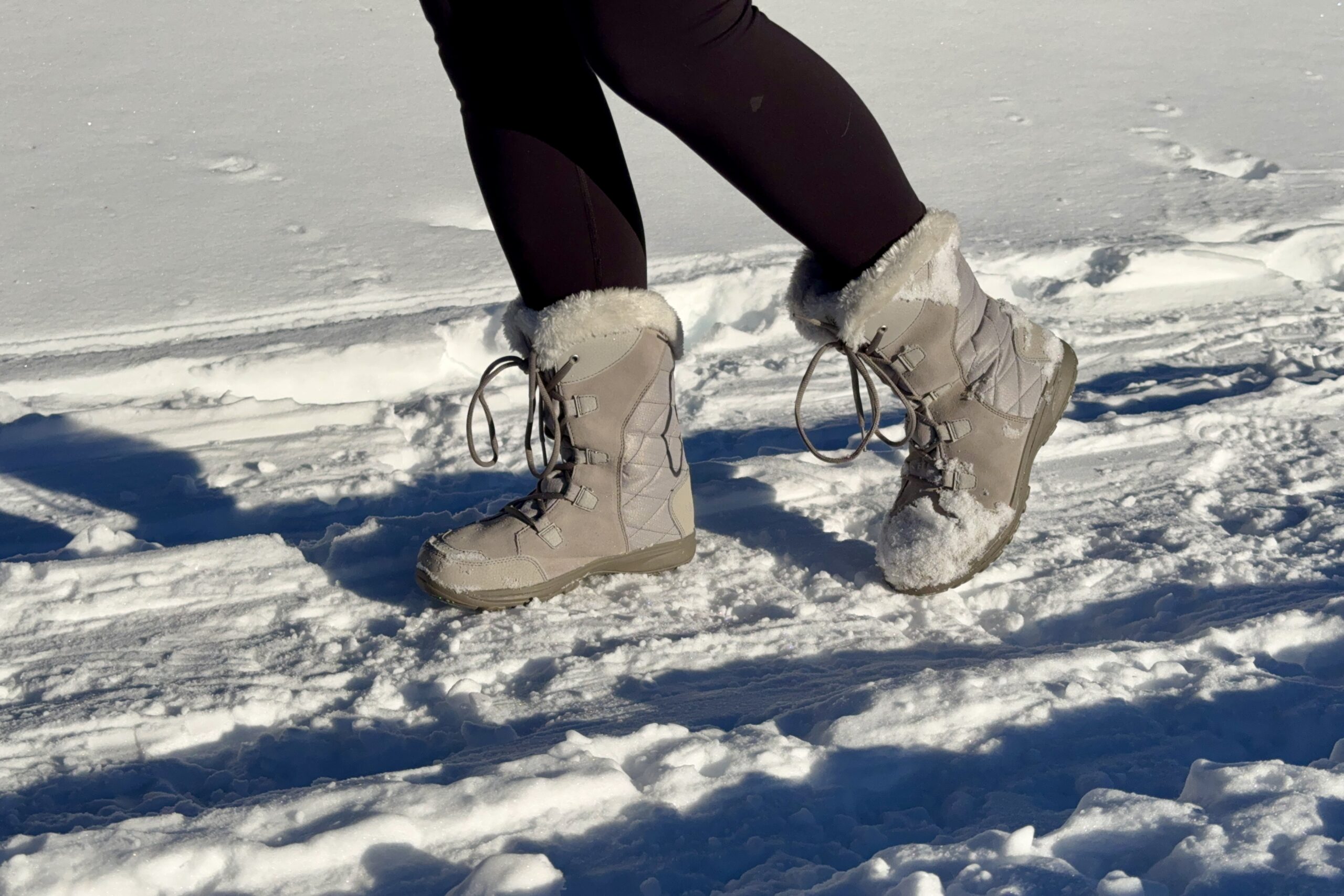
Product Comparison Table
| oSort | Product | Price | Weight | Temperature Rating | Insulation | Also Available In | Sizing | Weight Score | Water Resistance | Warmth | Comfort | Traction | 0 |
Oboz Bridger 7” Insulated View at REI View at Amazon |
$210 | 2 lb. 9 oz. | Not rated | 200 g Synthetic fibers | 9″ | True to size | 4.1 | 4.5 | 4.9 | 4.7 | 4.9 | 1 |
UGG Adirondack III View at Amazon View at Backcountry |
$250 | 2 lb. 8.6 oz. | -25°F | 200 g Upcycled Wool | Tall | Runs small; we recommend choosing a half size larger | 4.2 | 4.7 | 4.8 | 4.6 | 4.6 | 2 |
Thermal Women’s Chelsea View at REI View at Amazon |
$230 | 1 lb. 13.8 oz. | Not rated | Synthetic Fibers | Original, high topped boot, heeled | Blundstones come in Australian sizing, make sure to look at the sizing chart before buying online | 4.8 | 4.1 | 4.7 | 4.0 | 4.4 | 3 |
Columbia Minx Shorty IV View at Amazon View at Columbia |
$110 | 1 lb. 8 oz. | -25°F | 200 g Synthetic Fibers | Regular & Mid | True to sizing | 4.9 | 3.7 | 3.7 | 4.9 | 4.3 | 4 |
Bogs Arcata Snow Boot View at Amazon View at REI |
$160 | 3 lb. 1 oz. | -58°F | 7 mm Neo-tech neoprene | Urban leather tall, urban leather mid, urban leather chelsea | True to sizing | 3.9 | 4.8 | 4.5 | 4.0 | 4.2 | 5 |
Bogs Neo Classic Tall View at REI View at Amazon |
$140 | 3 lb. 6 oz. | -58°F | 5 mm Neo-tech neoprene | Mid & Wide calf | Runs large, we recommend sizing down half a size if you are unsure | 3.7 | 5.0 | 4.0 | 4.0 | 4.2 | 6 |
Merrell Thermo Chill Mid View at REI View at Amazon |
$130 | 1 lb. 14 oz. | Not rated | 200 g synthetic, micro-fleece lining | None Listed | Fits a bit tight, we recommend sizing up half a size | 4.6 | 4.5 | 4.1 | 3.6 | 4.0 | 7 |
Keen Revel IV Polar View at REI View at Amazon |
$190 | 2 lb. 8.64 oz. | -25°F | 200 g synthetic Fiber | High top | True to sizing | 4.1 | 3.4 | 4.3 | 4.2 | 4.7 | 8 |
Sorel Caribou View at REI View at Amazon |
$200 | 3 lb. 6 oz. | -40°F | 9 mm Recycled felt | Wool liner | True to sizing | 3.5 | 4.7 | 3.8 | 4.5 | 4.2 | 9 |
Columbia Ice Maiden II View at Amazon View at Columbia |
$100 | 2 lb. 1.6 oz. | -25°F | 200 g Synthetic fibers | Slip-On, Shorty | True to sizing | 4.5 | 3.8 | 3.8 | 4.8 | 3.9 |
|---|
How We Test & Methodology
We rigorously tested each set of winter boots using various metrics to determine which one is the best. Our process evaluated weight, water resistance, warmth, comfort, and traction. We wore these boots daily to work, around town, at the ski hill, and on hikes to help us find the best boot.
WEIGHT
Based on our experience, the heavier a boot is, the more exhausting it becomes to walk in. That’s why we ensured we weighed every boot we tested and compared their weights. Our process involved using a kitchen scale to weigh each boot individually. We then ranked the boots from first to tenth place based on their weights. Each boot received a score according to its rank.
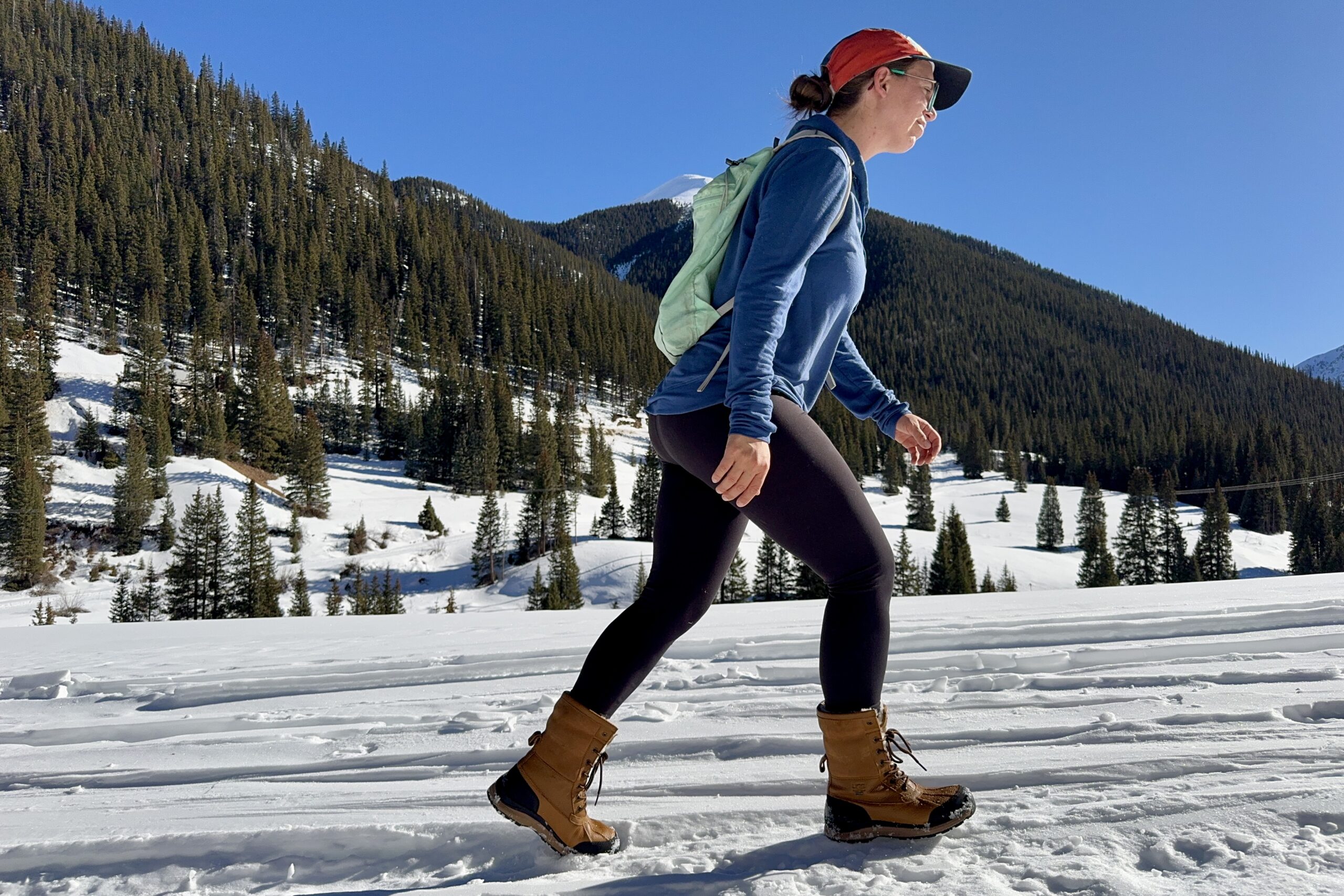
WATER RESISTANCE
Keeping out water is critical in wet and cold weather, which is why we wanted to test the waterproofing of each pair of boots. To do this, we filled a bathtub with a few inches of water, just enough to reach the lower laces on each boot. Then, we placed rocks in each boot since most of them would float, helping to keep the boots submerged. We set a stopwatch to track how long the boots were in the water and a five-minute timer to remind us to check the boots. When the timer went off, we checked the inside of each boot for any signs of water leakage. If a boot leaked, we recorded the duration it had been in the water and used that information to rank each boot. The boots that lasted over two hours, which is when we stopped recording, became our top-ranked boots.
WARMTH
Cold feet are no joke, especially when it comes to standing around in the snow. We know this because our toes were frozen solid by the time we finished testing our lineup while wearing a boot that didn’t make the cut. To test warmth, we placed each boot in the snow and covered the lower part with snow. The boots were tested side by side, and the patch of snow we selected was in the shade. It was late afternoon during the test, and the temperatures were dropping as the sun moved lower in the sky. We used a laser thermometer to measure the temperature inside each boot. We took readings as soon as the boots were placed in the snow and every five minutes over the course of half an hour. Our rankings are based on the lowest temperature reading for each boot, which occurred at the 25-minute mark.
COMFORT
Comfort can be a challenging metric to evaluate since everyone has different feet, and what feels comfortable for one person may be uncomfortable for another. To address this, we focused on the features that allow individuals to customize or find the best fit in each model. The more customization options available, the higher the likelihood that someone can find a version that suits their comfort needs. We specifically examined whether each model offers half sizes, a wide toe box option, removable inserts for orthotics, adjustable lacing, and responsive customer service for returns or trying out a different version if necessary. Subsequently, we ranked each model based on the number of these features it offers.
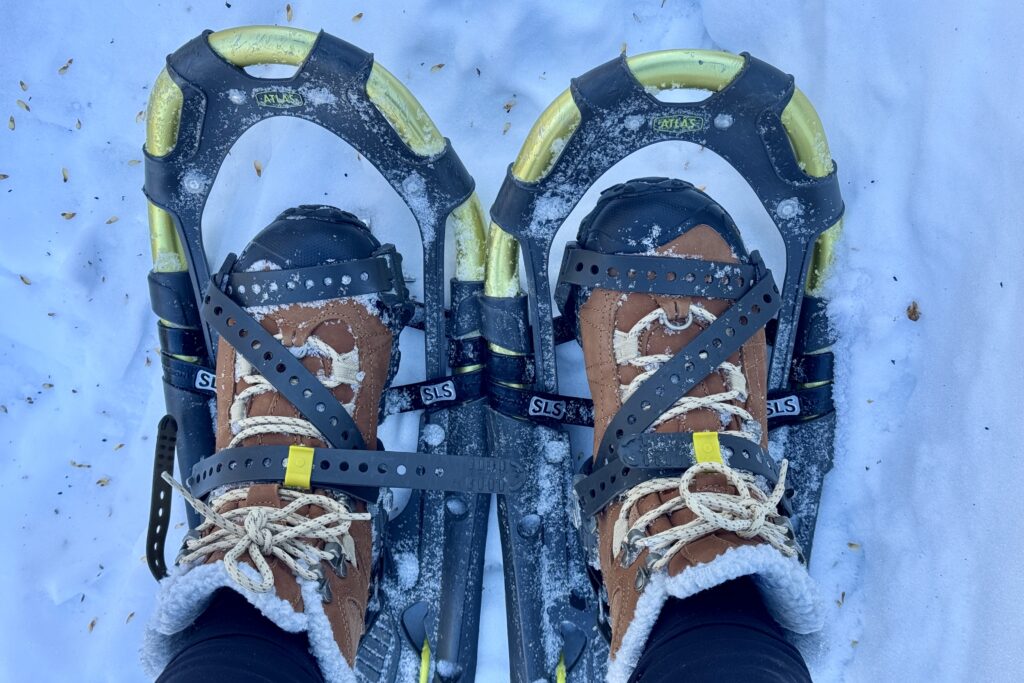
TRACTION
To test the traction of each boot, we built a traction machine to evaluate the friction of each boot. It is important to us to ensure that everything is as consistent as possible during testing, which is why we chose this method. The machine consisted of a rotating lever arm with a flat rock at the end. Each boot was placed on the rock, and then the arm was slowly raised. As the angle between the ground and the bottom of the boot increased, gravity had a greater impact on the boot. More friction was needed to prevent the boot from sliding off the rock. The boot with the best traction achieved the largest angle measurement before it ultimately fell off, thereby securing the best ranking. We used a construction protractor to measure the angle.
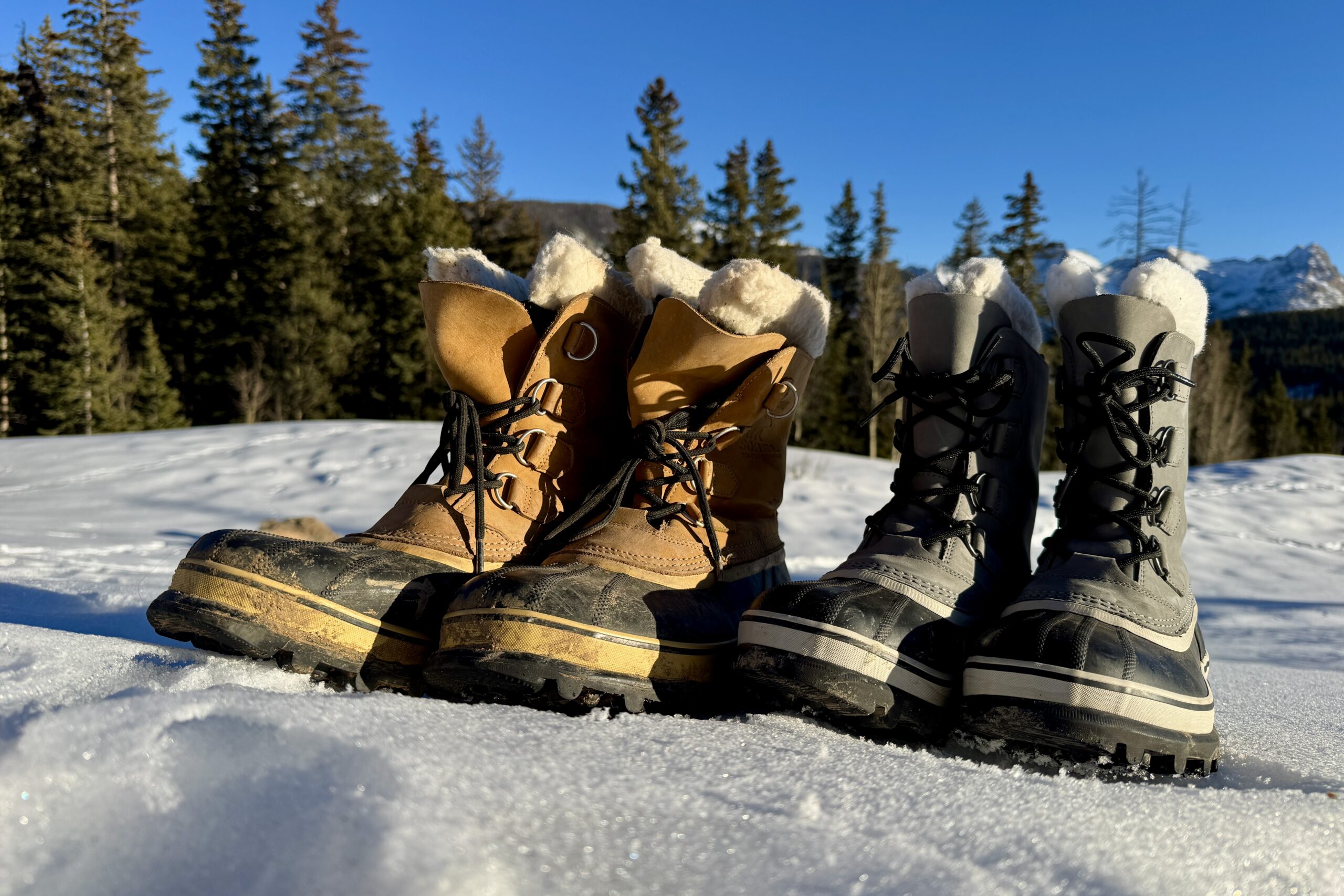
Why Trust CleverHiker
Gear analyst Bailey Bremner has spent over 600 nights and nearly 8,500 miles on trails across the U.S., in addition to growing up and living in snowy environments her whole life. Living in Alaska, in particular, helped her appreciate the importance of a good winter boot. When she isn’t out backpacking, she enjoys downhill skiing, Nordic skiing, and snowshoeing.
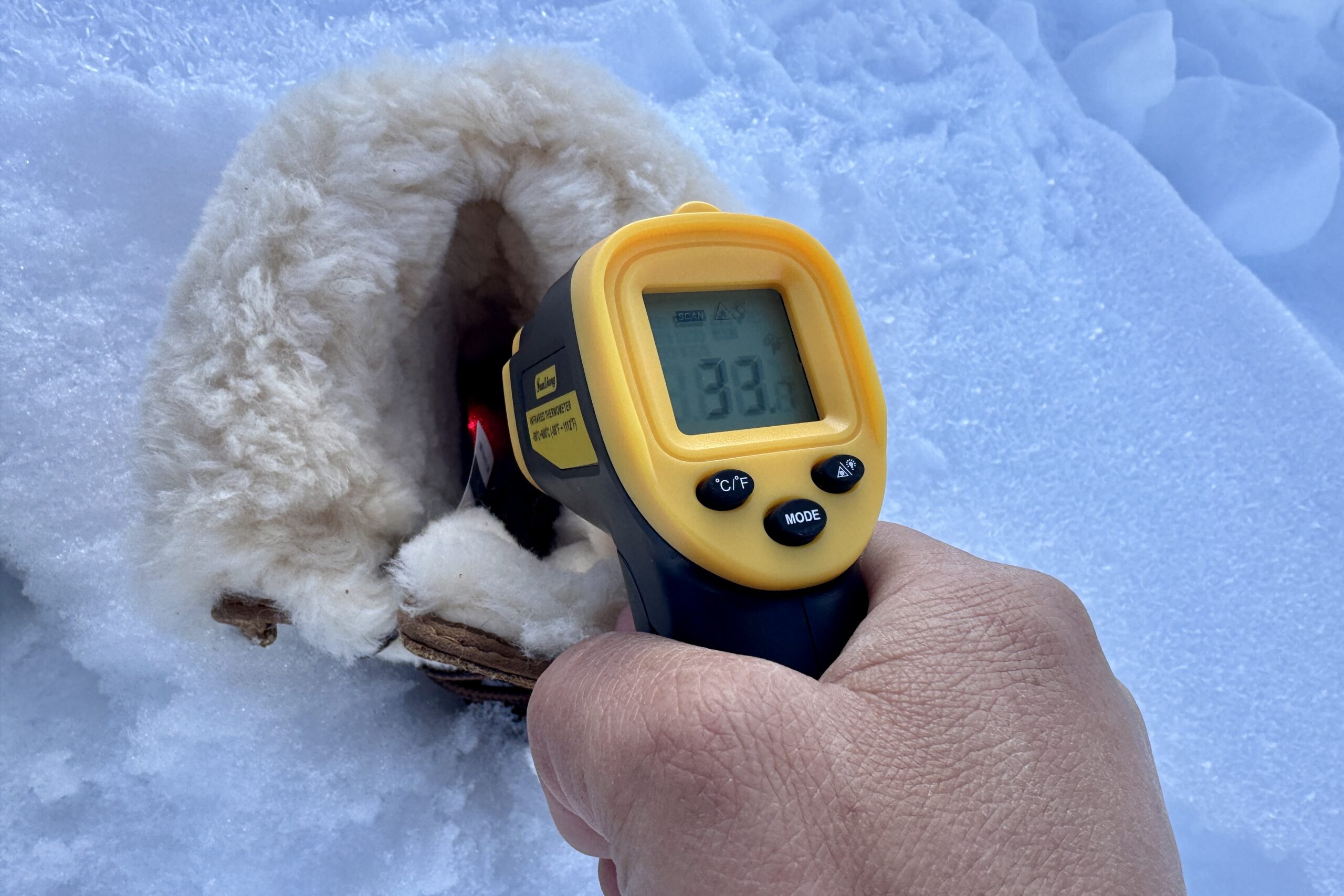
Analysis & Results
We rank winter boots using five metrics: weight, water resistance, warmth, comfort, and traction, while also taking their value into account. Our comparative results below highlight the top performers in each metric.
VALUE
We genuinely love using every pair of boots in this review, as each has unique strengths for different occasions. Because of this, we believe that all of these boots offer considerable value when used appropriately. Some of the boots we tested can be on the expensive side, but they typically feature genuine leather construction. This material is durable and performs exceptionally well in wet conditions, making the price worthwhile in these instances.
Most of the more affordable options are crafted from less expensive materials. We still appreciate these boots; however, they tend to be less versatile overall. That said, we awarded the Columbia Minx Shorty IV our Budget Buy badge, as they are not only affordable but also provided us with extensive use thanks to their versatility for various occasions.
WEIGHT
Generally, casual and minimalist designs are lighter than taller snow boots, while hiking-specific boots typically fall somewhere in between. When we placed one boot from each pair on a kitchen scale, we found that the Columbia Minx Shorty IV was the lightest model at 13 ounces. The Blundstone Thermal Women’s Chelsea and the Merrell Thermo Chill Mid closely followed at 14.9 and 15.8 ounces, respectively. All three of these boots are easier to move in due to their light weight and offer more comfort for extended wear when properly fitted.
In contrast, the heavy-duty boots weighed significantly more. When we weighed the Bogs Neo Classic Tall boots, the scale showed 27.2 ounces, or about 1.7 pounds. The Sorel Caribou were even heavier at 31.6 ounces, nearly two pounds! Based on our experience wearing all of these boots, that extra weight can lead to foot fatigue after a long day and make walking more frustrating. Properly fitting the boots can help mitigate this issue.
WATER RESISTANCE
The materials and overall design of the boot significantly influence water resistance. Some of the boots we tested are completely waterproof as long as moisture does not enter from the top. Leather and neoprene rubber are both great choices to prevent water from getting in. Other boots are simply water-resistant and will wet out after a certain amount of time. Thanks to the neoprene material and seamless design, both of the Bogs boots we evaluated are entirely waterproof.
We rated the Neo Classic Tall boots higher because the tall upper can keep more moisture out than the Arcata boots. Conversely, the Keen Revel IV Polar boots became wet inside after less than 20 minutes during our testing. While the lower part of the boot is made of leather, making it waterproof, the tongue is fabric and soaked up water immediately. Additionally, the gusseting on the tongue does not rise as high as on other models.
Both Columbia boots also struggled with moisture. The Ice Maiden II and Minx Shorty IV feature extensive fabric on both the lower and upper parts of the boot. Although treated for water resistance, it takes about 45 minutes for both of these boots to wet out.
WARMTH
During the warmth test, we discovered several boots with excellent insulation. At the top of our list is the Oboz Bridger 7”, which ranked as the warmest after spending time in the snow during the test, and it was also one of the warmest models we used in the field. The overall insulation of this boot is impressive, and the synthetic wool at the cuff feels nice and cozy.
Another favorite of ours is the UGG Adirondack II. This boot features recycled wool on both the cuff and throughout the entire boot, making it both warm and extremely comfortable to wear. This was particularly evident when we wore it indoors as well as during the side-by-side test.
At the bottom of our rankings are both Columbia boots and the Sorel Caribou. The Sorel combines rubber and leather for the outside of the boots, but the inside is made of a felt liner. This is ideal for high output activities like shoveling, but it may not provide as much warmth for sitting around.
The Ice Maiden II and Minx Shorty IV also had cold internal temperatures when we placed them in a snowdrift. Both of these boots are more affordable than others on the list, suggesting that the insulation is likely not as high of quality.
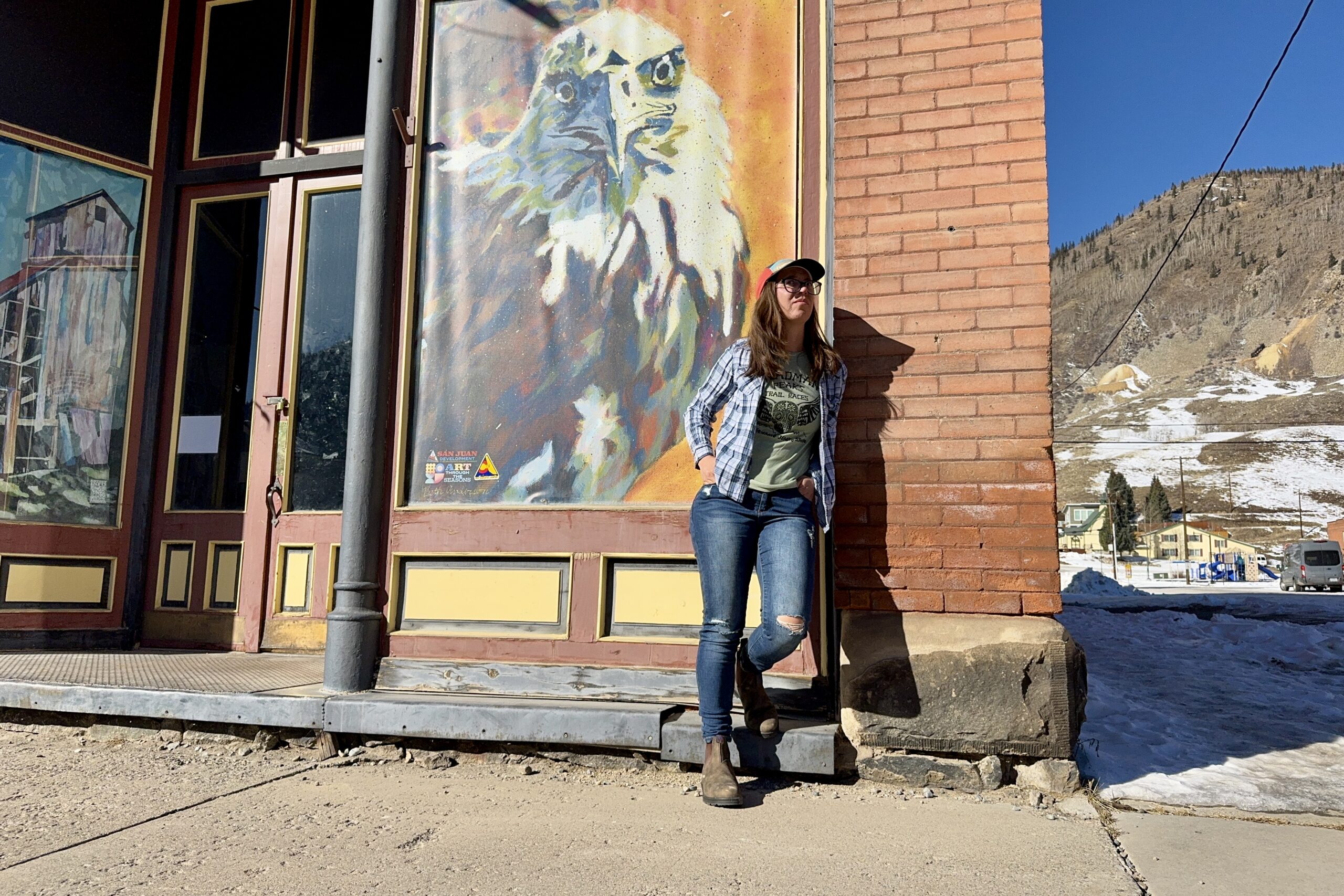
COMFORT
We have a clear winner when it comes to comfort. The Columbia Minx Shorty IV offers various sizing options and adjustability points, making this boot comfortable for a wide range of users. Its extremely lightweight design also enhances comfort, requiring less effort to move, especially over extended periods.
Our experience showed that these boots felt great for all-day wear. The Columbia Ice Maiden II shares many of the same comfort features but is slightly heavier, resulting in some foot fatigue, which is why it ranked second.
At the bottom of the list were both pairs of Bogs and the Merrell Thermo Chill Mid. We didn’t experience any major comfort issues with the Bogs Neo Classic Tall or the Bogs Arcata Snow Boots, but they lack a variety of sizing options and adjustable features. The Thermo Chill Mids were a bit disappointing for us. They have many excellent attributes, but the ankle shape didn’t align well with our tester’s leg shape, leading to significant discomfort.
TRACTION
We used a combination of the traction machine we built, the tread surface area, and our own experience with these boots to rank them. After concluding these tests, we found that the Oboz Bridger 7” had the best overall traction. These boots performed really well on the traction machine and also have beefy tread that is suitable for hiking.
The Keen Revel IV Polar also has great grip thanks to grippy material on the soles and tread that has a lot of surface area. The Columbia Ice Maiden II ranked lowest due to its poor performance in side-by-side testing and minimal lugs on the boot’s bottom.

How to Choose WINTER BOOTS
PRICE
Materials like insulation and waterproofing can significantly impact price. While the most expensive isn’t always the best, selecting a boot that provides good value and performance relative to the cost will help to maximize comfort.
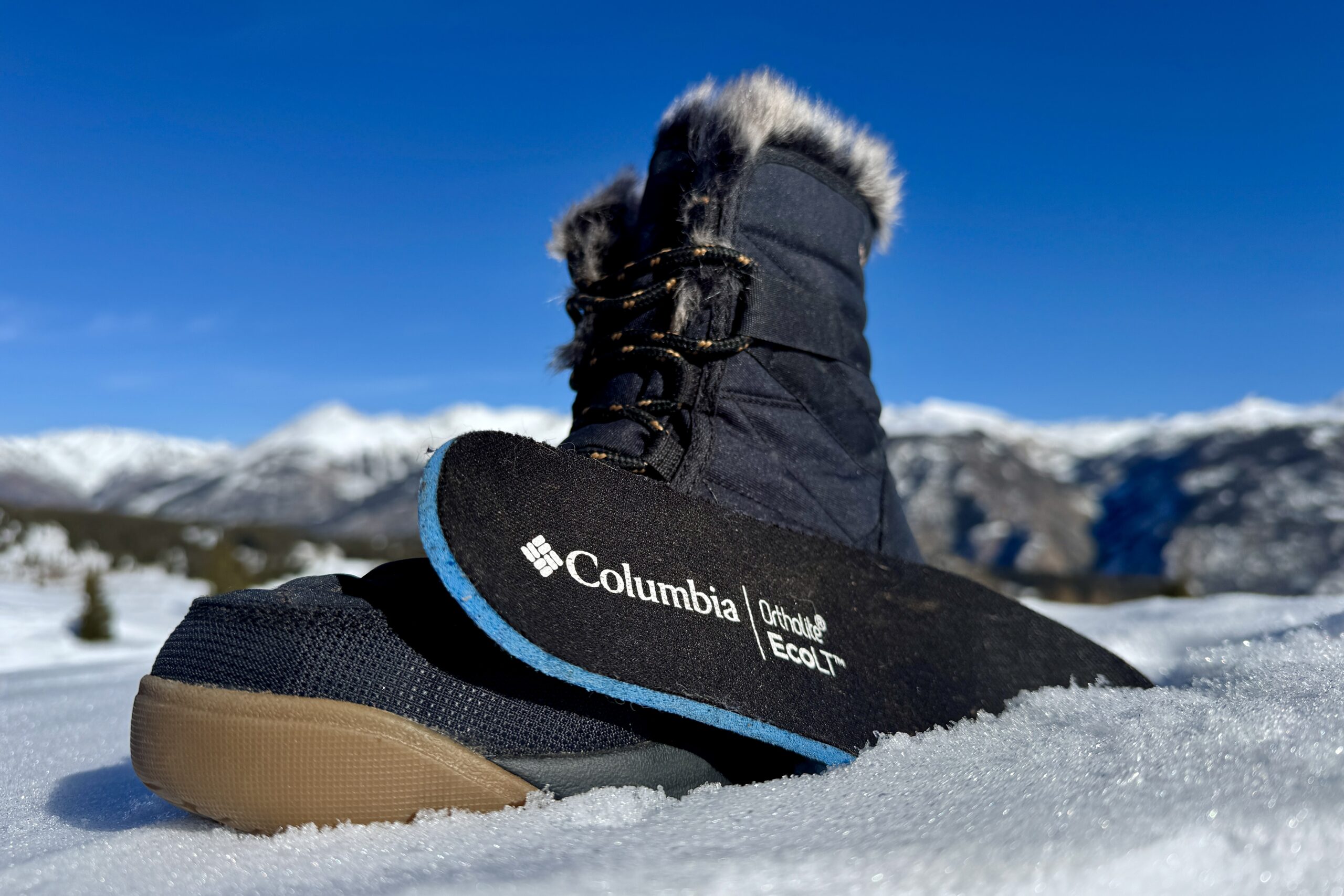
USAGE
There is a wide variety of differences in the boots we tested. Some boots are designed for hiking, while others have features that make them ideal for shoveling snow or walking around town. Ankle-high boots with variable lug patterns are better suited for hiking. In contrast, taller boots with more insulation are great for driving to work on a snowy day. It’s worth considering the primary activity for which the boot will be used before purchasing it.
INSULATION
The intended use will also help determine how much insulation is needed. Activities like hiking, which involve a lot of movement, require less insulation than boots designed for riding snowmobiles. Winter-specific boots are generally insulated with materials such as fleece, wool, or synthetic fibers. As a result, feet usually do not get extremely cold when wearing them.
Thick socks can provide additional insulation, particularly for uninsulated, waterproof boots. Just ensure to select a size that has extra room to accommodate the socks.
BOOT HEIGHT AND GAITERS
Taller boots are ideal for cold weather and deep snow because they do a better job of keeping out moisture. However, ankle-height boots are usually easier to walk and move in. A good compromise can be found by using winter-specific gaiters.
These attach to the bottom of the boot and cover the opening at the top to prevent moisture coming in. We like gaiters because they can typically be used with any style of footwear, and they increase overall comfort. Some boots even feature dedicated attachment points for the gaiters.
TRACTION
Activities with a lot of movement, such as hiking, or in areas with lots of ice will require more traction to keep from slipping. We suggest choosing boots with more aggressive tread to help with traction. If conditions are extremely slick, the boots can be paired with a traction device or crampon.
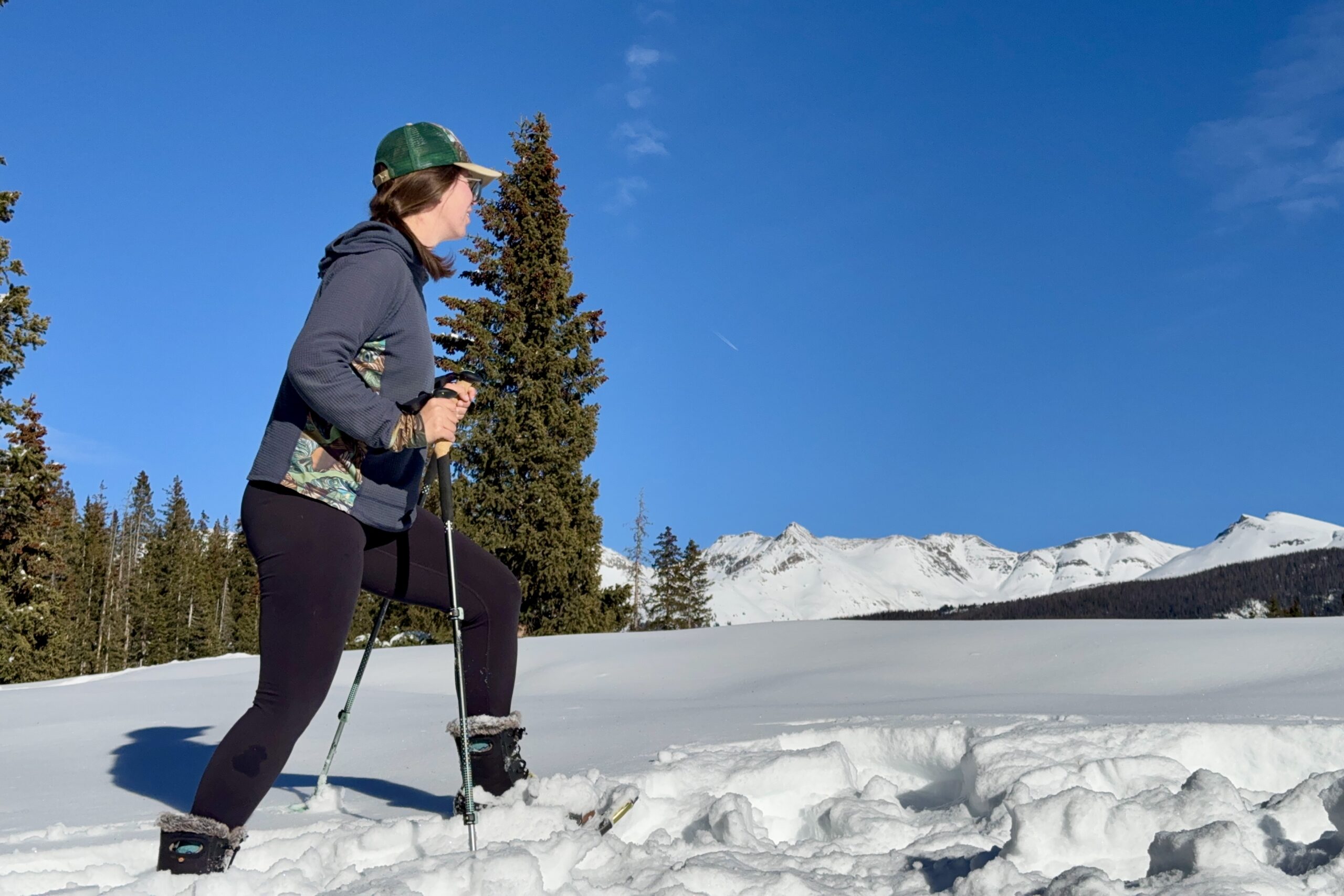
TRACTION
Activities with a lot of movement, such as hiking, or in areas with lots of ice will require more traction to keep from slipping. We suggest choosing boots with more aggressive tread to help with traction. If conditions are extremely slick, the boots can be paired with a traction device or crampon.
WEIGHT
Extra weight on the feet can be exhausting throughout the day. Bulky and heavy boots often feel awkward and challenging to wear. Heavier boots are usually warmer and better suited for cold conditions and deep snow. The intended use will again determine what weight is appropriate for the boot. Though we tend to lean towards lighter boots, selecting the proper size can also lessen the overall weight and cumbersome feel of footwear.
LINERS
There are pros and cons to choosing boots with liners. We appreciate liners because they are easy to remove and dry if they get wet. They can also be replaced, which helps extend the life of the boots. The downside is that liners typically do not fit as snugly and can be less comfortable for long periods of walking. However, this is less problematic if the boots are only used to clear snow off the car or for quick trips to the store. For boots intended for hiking or higher-paced activities, a tighter fit will make movement easier. Boot dryers can also be used to help them dry faster.
INSOLES
Upgrading the insoles can help improve the comfort and warmth of a boot. Well-known brands like Superfeet provide insoles that are warm, cushy, and more supportive than those that come with the boots. Just be sure to consider the additional space required to fit thicker insoles.
WEATHER PROOFING
Some materials are inherently more waterproof than others. Naturally, waterproof materials like rubber will repel moisture for longer periods of time than treated fabrics. It’s important to consider weak points or other areas where moisture might seep into the boot and plan accordingly during use.
Conclusion
There are many different types of winter boots, and the selection can be overwhelming! However, by considering the intended use and how each boot performs in various situations, you can narrow down the list. Our goal is to provide the necessary information to help you choose a boot for your situation, and we hope you find success.
